A CAM lesion is the formation of extra bone on the head of the femur (ball) resulting in a ‘bump’. This extra bone can cause pain as it impinges with the acetabulum (socket) with joint movement. A Cam lesion is commonly seen in conditions such as Femoro-Acetabular Impingement (FAI) and in some cases can lead to labral tears.
The evidence from the literature suggests that cam deformities develop in adolescents that are involved in sports that are subject to high rotational forces across the hip such as AFL football and soccer. Cam deformities can lead to an increased risk of osteoarthritis in later life.
Common Symptoms of Cam lesions;
- Restricted hip movement – especially twisting the hip in and flexing the hip up
- Deep hip pain, groin pain or buttock pain particularly with twisting type activities ie cutting, pivoting especially on a planted foot
- Pain and restriction with deep squatting, getting out of a car, sitting in a low chair
- Less common – referred thigh or knee pain
Treatment and Investigations
All Physica staff receive extra training in the diagnosis and management of Cam lesions and FAI. We will conduct a thorough assessment and devise an appropriate course of action including referral for specific radiology to confirm diagnosis. A Cam lesion can often be seen on a plain X-ray however if a labral tear is suspected a MRI may be warranted.
After diagnosis our physiotherapists will develop a specific rehabilitation program to address biomechanical and any other contributing factors to ensure the reduction of joint impact with activities. We will also discuss with you an appropriate course of action for long term management; this may include referral to specialists for surgical opinion.
If surgery is indicated hip arthroscopy is used to trim away the extra bone. This helps to restore normal movement of the hip joint and takes pressure of the acetabulum(socket). Hip arthroscopy is a day procedure and patients are often weight bearing immediately after the procedure with crutches. Strengthening of the deep gluteals along with quadriceps and hamstring strengthening are essential to ensure a good outcome.

